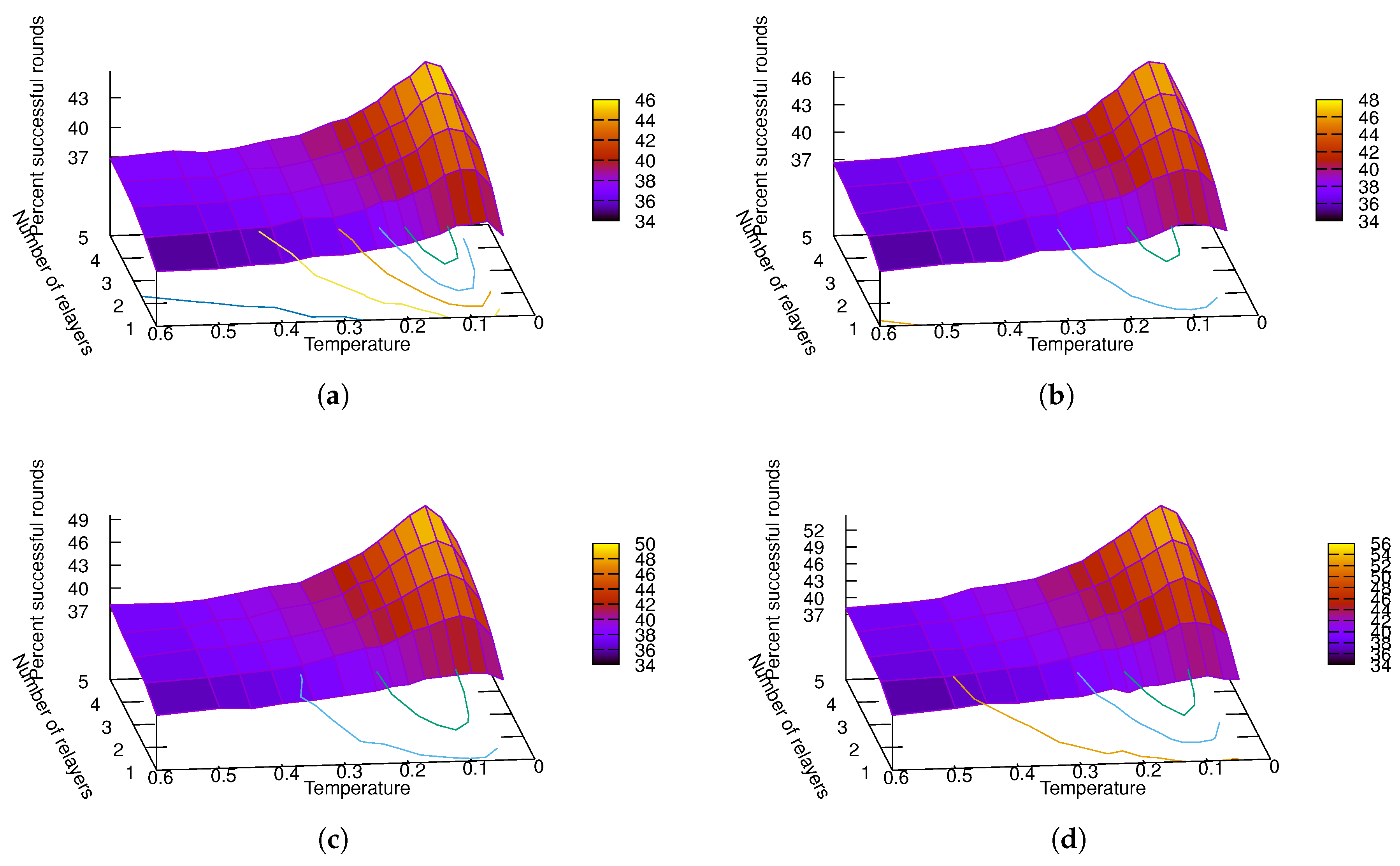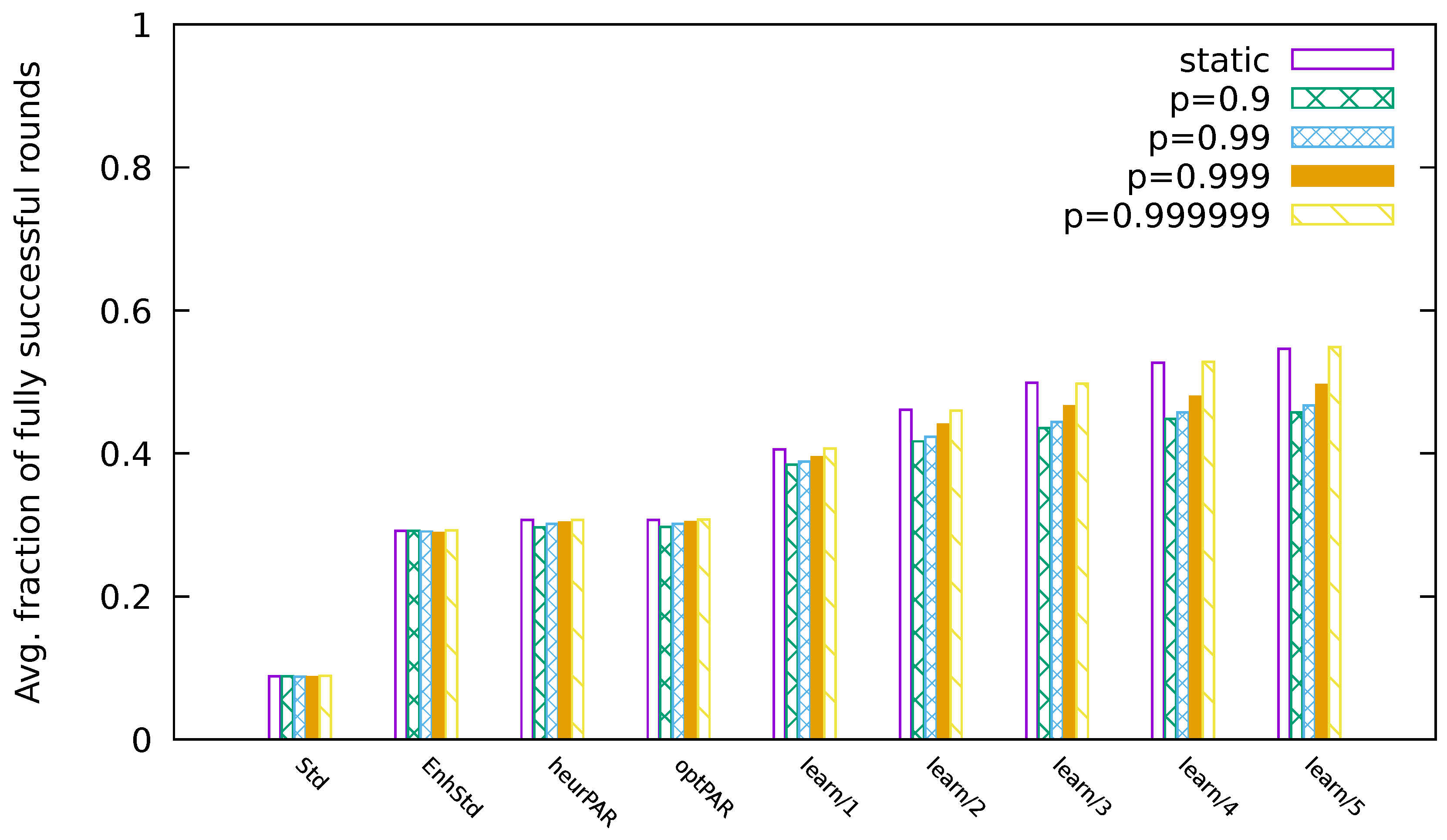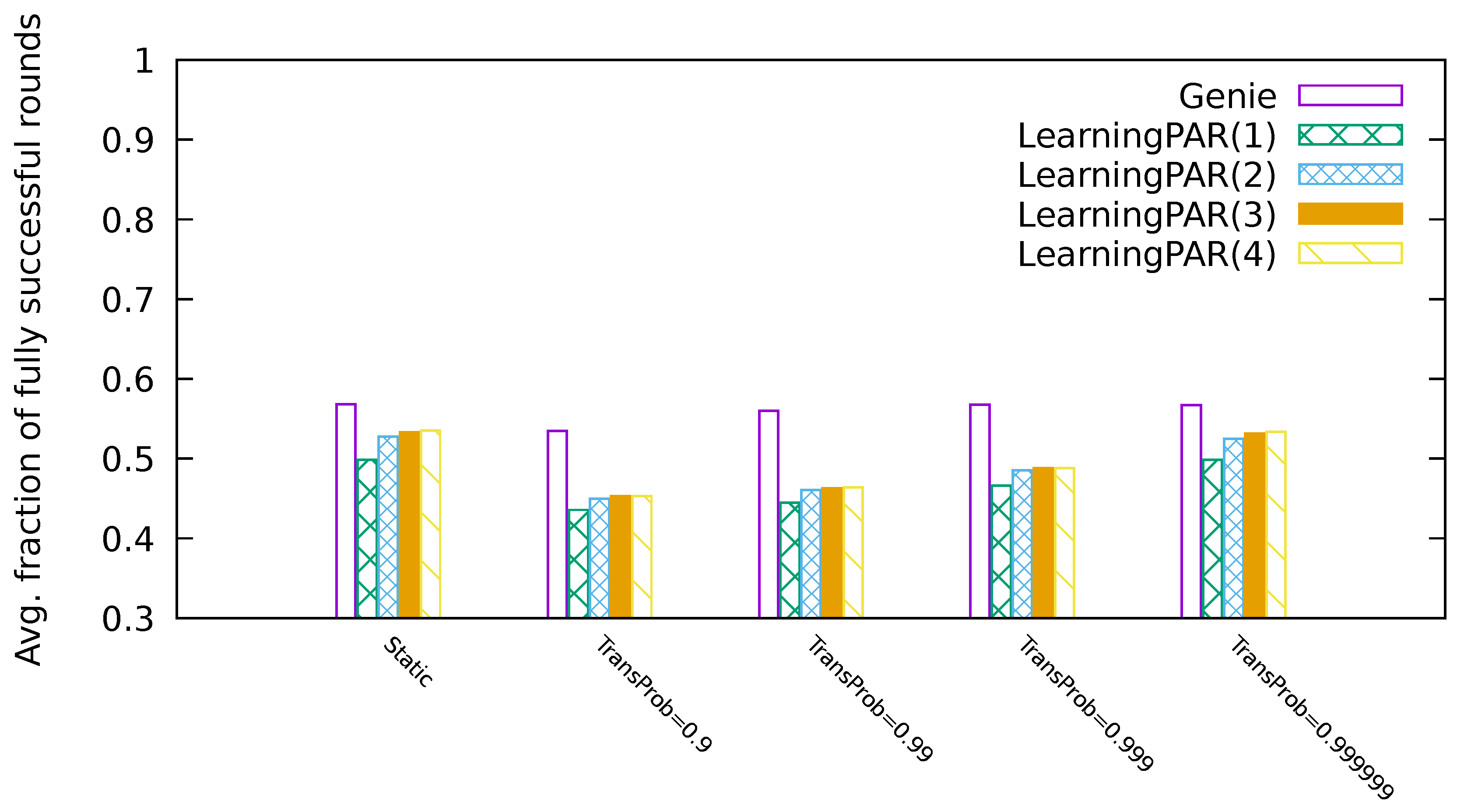Relayer-Enabled Retransmission Scheduling in 802.15.4e LLDN—Exploring a Reinforcement Learning Approach
Abstract
:1. Introduction
2. Background and System Model
2.1. Background on IEEE 802.15.4e LLDN
2.2. System Model
3. Non-Relaying Schemes
3.1. Standard-Based Schemes
3.2. The Optimal(PAR) Scheme
3.3. The Heuristic(PAR) Scheme
| allocate slot to failed source j |
4. Relaying Schemes
4.1. Learning-Based Scheme
4.2. Genie-Aided Scheme
4.3. Overheads
5. Simulation Framework
6. Results
6.1. Choosing the System Temperature for the Learning(PAR) Scheme
6.2. Performance on Static Channels
- source nodes, retransmission slots,
- source nodes, retransmission slots,
- source nodes, retransmission slots.
- The results for the success probability show a much wider spread (both when varying the number of sources and among the different schemes) than the fraction of successful packets. For the non-relaying schemes (except the standard scheme), the difference in the average fraction of successful packets is small, and the increase of that fraction for increasing numbers of relayers is moderate. Similar findings apply for all of the other scenarios studied in this paper, and we will not report further results on the fraction of successful packets.
- The standard scheme shows consistently and by some margin the poorest success probability performance. By comparing the standard scheme with the enhanced standard scheme, we can conclude that not utilizing all available retransmission slots significantly reduces the success probability.
- The success probability achieved by the heuristic(PAR) and optimal(PAR) schemes is very close, confirming that the heuristic proposed in Section 3.3 gives a very good approximation to the true optimum.
- Somewhat to our surprise, the heuristic(PAR) scheme shows almost the same success probability performance as the enhanced standard scheme—for six and eight sources, the advantage of heuristic(PAR) over the enhanced standard scheme is only on the order of 1% to 1.5% in absolute percentages.
- The biggest improvements can be achieved with the learning(PAR) scheme, in particular as more relayers are added to the system. For sources and relayers, the learning(PAR) scheme achieves almost twice the success probability of the heuristic(PAR) scheme; for smaller numbers of source nodes, the relative advantage is smaller but still significant. These results are even more encouraging when noting that the channels are completely random—with a carefully planned deployment of relayers further performance, improvements can be expected.
6.3. Performance on Time-Varying Channels
- The standard and enhanced standard schemes show more or less no sensitivity to the channel stability. The other two non-relaying schemes (heuristic(PAR), optimal(PAR)) show light performance improvements as the channel stability increases. We attribute this to the time required for the EWMA-based PER estimator (Equation (1)) after a channel change to adapt to the new channel PER. During this transient adaptation phase, sub-optimal allocation decisions can be made.
- When compared to static channels, the learning(PAR) scheme shows a reduced success probability performance over time-varying channels, particularly for smaller channel stability values. When the channel stability value becomes larger, the success probability of the learning(PAR) scheme approaches that for static channels, since, for larger channel stability values, the channels remain stable longer, and the fraction of time spent by the learning(PAR) scheme to learn the new channels becomes relatively smaller.
- Despite the performance loss observed over time-varying channels, it is still true for the learning(PAR) scheme that adding relayers gives significant success probability gains over the non-relaying schemes.
6.4. Enlarging the Action Space
- Extending the action space for the learning(PAR) scheme has diminishing returns beyond for all considered channel models. The improvement from to is visible (most for the case of static channels), but, beyond this, it becomes marginal.
- In the case of static channels (and the time-varying channel with the largest channel stability), there is still a noticeable performance gap between the best learningPAR() scheme and the genie(PAR) scheme. We suspect that this gap is the price paid for the process of exploration, i.e., for the Boltzmann-based action selection scheme not selecting the best available action (which will have been learned after some time) throughout, but only with higher probability than other actions. Another possible explanation could have been the limited size of the action space when compared to the genie(PAR) scheme, but our finding of diminishing returns for increasing does not support this hypothesis.
- The performance gap between the best learningPAR() scheme and the genie(PAR) scheme is even larger for time-varying channels with lower channel stability. The additional performance losses compared to static channels can be attributed to the transient times where the learningPAR() scheme needs to adjust to changed channels.
7. Related Work
8. Conclusions
Acknowledgments
Author Contributions
Conflicts of Interest
References
- Galloway, B.; Hancke, G.P. Introduction to Industrial Control Networks. IEEE Commun. Surv. Tutor. 2013, 15, 860–880. [Google Scholar] [CrossRef]
- Gungor, V.C.; Hancke, G.P. Industrial Wireless Sensor Networks: Challenges, Design Principles, and Technical Approaches. IEEE Trans. Ind. Electron. 2009, 56, 4258–4265. [Google Scholar] [CrossRef]
- Willig, A. Recent and Emerging Topics in Wireless Industrial Communications: A Selection. IEEE Trans. Ind. Inform. 2008, 4, 102–124. [Google Scholar] [CrossRef]
- LAN/MAN Standards Committee of the IEEE Computer Society. IEEE Standard for Local and Metropolitan Area Networks—Part 15.4: Low Rate Wireless Personal Area Networks (LR-WPANs); Revision of 2011; Institute of Electrical and Electronics Engineers: Piscataway, NJ, USA, 2011. [Google Scholar]
- Toscano, E.; Bello, L.L. Multichannel Superframe Scheduling for IEEE 802.15.4 Industrial Wireless Sensor Networks. IEEE Trans. Ind. Inform. 2012, 8, 337–350. [Google Scholar] [CrossRef]
- IEEE Computer Society. IEEE Standard for Local and Metropolitan Area Networks–Part 15.4: Low-Rate Wireless Personal Area Networks (LR-WPANs)— Amendment 1: MAC Sublayer; IEEE Std 802.15.4e-2012; Institute of Electrical and Electronics Engineers: Piscataway, NJ, USA, 2012. [Google Scholar]
- Chen, F.; German, R.; Dressler, F. Towards IEEE 802.15.4e: A Study of Performance Aspects. In Proceedings of the 8th IEEE International Conference on Pervasive Computing and Communications (PERCOM Workshops), Mannheim, Germany, 29 March–2 April 2010; pp. 68–73. [Google Scholar]
- Diggavi, S.N.; Al-Dhahir, N.; Stamoulis, A.; Calderbank, A.R. Great Expectations: The Value of Spatial Diversity in Wireless Networks. IEEE Proc. 2004, 92, 219–270. [Google Scholar] [CrossRef]
- Willig, A.; Uhlemann, E. Deadline-Aware Scheduling of Cooperative Relayers in TDMA-Based Wireless Industrial Networks. Wirel. Netw. 2014, 20, 73–88. [Google Scholar] [CrossRef]
- Sutton, R.S.; Barto, A.G. Reinforcement Learning—An Introduction; MIT Press: Cambridge, MA, USA, 1998. [Google Scholar]
- Bertsekas, D.P.; Tsitsiklis, J.N. Neuro—Dynamic Programming; Athena Scientific: Belmont, MA, USA, 1996. [Google Scholar]
- Willig, A.; Matusovsky, Y.; Kind, A. Retransmission Scheduling in 802.15.4e LLDN—A Reinforcement Learning Approach with Relayers. In Proceedings of the International Telecommunication Networks and Applications Conference (ITNAC) 2016, Dunedin, New Zealand, 7–9 December 2016. [Google Scholar]
- Girs, S.; Willig, A.; Uhlemann, E.; Bjoerkman, M. Scheduling for Source Relaying with Packet Aggregation in Industrial Wireless Networks. IEEE Trans. Ind. Inform. 2016, 12, 1855–1864. [Google Scholar] [CrossRef]
- Feller, W. An Introduction to Probability Theory and Its Applications—Volume I, 3rd ed.; John Wiley: New York, NY, USA, 1968. [Google Scholar]
- Korte, B.; Vygen, J. Combinatorial Optimization—Theory and Algorithms, 3rd ed.; Springer: Berlin, Germany, 2005. [Google Scholar]
- Bertsekas, D.P. Nonlinear Programming, 2nd ed.; Athena Scientific: Belmont, MA, USA, 1999. [Google Scholar]
- Rappaport, T.S. Wireless Communications—Principles and Practice; Prentice Hall: Upper Saddle River, NJ, USA, 2002. [Google Scholar]
- Liu, K.J.R.; Sadek, A.K.; Su, W.; Kwasinski, A. Cooperative Communications and Networking; Cambridge University Press: Cambridge, UK, 2009. [Google Scholar]
- Kramer, G.; Maric, I.; Yates, R.D. Cooperative Communications. Found. Trends Netw. 2006, 1, 271–425. [Google Scholar] [CrossRef]
- Laneman, J.N.; Tse, D.N.C.; Wornell, G.W. Cooperative Diversity in Wireless Networks: Efficient Protocols and Outage Behaviour. IEEE Trans. Inf. Theory 2004, 50, 3062–3080. [Google Scholar] [CrossRef]
- Norris, J.R. Markov Chains; Cambridge University Press: Cambridge, UK, 1997. [Google Scholar]
- Marchenko, N.; Bettstetter, C. Cooperative ARQ with Relay Selection: An Analytical Framework Using Semi-Markov Processes. IEEE Trans. Veh. Technol. 2014, 63, 178–190. [Google Scholar] [CrossRef]
- Ni, W.; Collings, I.B.; Liu, R.P.; Chen, Z. Relay-Assisted Wireless Communication Systems in Mining Vehicle Safety Applications. IEEE Trans. Ind. Inform. 2014, 10, 615–627. [Google Scholar] [CrossRef]
- Marchenko, N.; Andre, T.; Brandner, G.; Masood, W.; Bettstetter, C. An Experimental Study of Selective Cooperative Relaying in Industrial Wireless Sensor Networks. IEEE Trans. Ind. Inform. 2014, 10, 1806–1816. [Google Scholar] [CrossRef]
- Momoda, M.; Hara, S. Use of IEEE 802.15.4 for a Cooperator-Assisted Wireless Body Area Network. In Proceedings of the 8th International Symposium on Medical Information and Communication Technology (ISMICT), Firenze, Italy, 2–4 April 2014; pp. 1–5. [Google Scholar]
- Yen, B.X.; Hop, D.T.; Yoo, M. Redundant Transmission in wireless networked control system over IEEE 802.15.4e. In Proceedings of the International Conference on Information Networking (ICOIN), Bangkok, Thailand, 28–30 January 2013; pp. 628–631. [Google Scholar]
- Dariz, L.; Malaguti, G.; Ruggeri, M. Performance Analysis of IEEE 802.15.4 real-time Enhancement. In Proceedings of the IEEE 23rd International Symposium on Industrial Electronics (ISIE), Harbiye Istanbul, Turkey, 1–4 June 2014; pp. 1475–1480. [Google Scholar]
- Palattella, M.R.; Accettura, N.; Grieco, L.A.; Boggia, G.; Dohler, M.; Engel, T. On Optimal Scheduling in Duty-Cycled Industrial IoT Applications Using IEEE802.15.4e TSCH. IEEE Sens. J. 2013, 13, 3655–3666. [Google Scholar] [CrossRef]
- Yadong, W.; Shihong, D. Study on IEEE802.15.4 Link Reliability in Industrial Environments. In Proceedings of the IEEE International Conference on Wireless for Space and Extreme Environments (WiSEE), Baltimore, MD, USA, 7–9 November 2013; pp. 1–7. [Google Scholar]





© 2017 by the authors. Licensee MDPI, Basel, Switzerland. This article is an open access article distributed under the terms and conditions of the Creative Commons Attribution (CC BY) license (http://creativecommons.org/licenses/by/4.0/).
Share and Cite
Willig, A.; Matusovsky, Y.; Kind, A. Relayer-Enabled Retransmission Scheduling in 802.15.4e LLDN—Exploring a Reinforcement Learning Approach. J. Sens. Actuator Netw. 2017, 6, 6. https://doi.org/10.3390/jsan6020006
Willig A, Matusovsky Y, Kind A. Relayer-Enabled Retransmission Scheduling in 802.15.4e LLDN—Exploring a Reinforcement Learning Approach. Journal of Sensor and Actuator Networks. 2017; 6(2):6. https://doi.org/10.3390/jsan6020006
Chicago/Turabian StyleWillig, Andreas, Yakir Matusovsky, and Adriel Kind. 2017. "Relayer-Enabled Retransmission Scheduling in 802.15.4e LLDN—Exploring a Reinforcement Learning Approach" Journal of Sensor and Actuator Networks 6, no. 2: 6. https://doi.org/10.3390/jsan6020006
APA StyleWillig, A., Matusovsky, Y., & Kind, A. (2017). Relayer-Enabled Retransmission Scheduling in 802.15.4e LLDN—Exploring a Reinforcement Learning Approach. Journal of Sensor and Actuator Networks, 6(2), 6. https://doi.org/10.3390/jsan6020006





